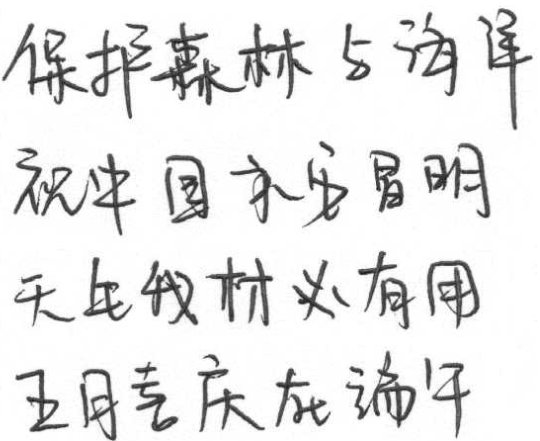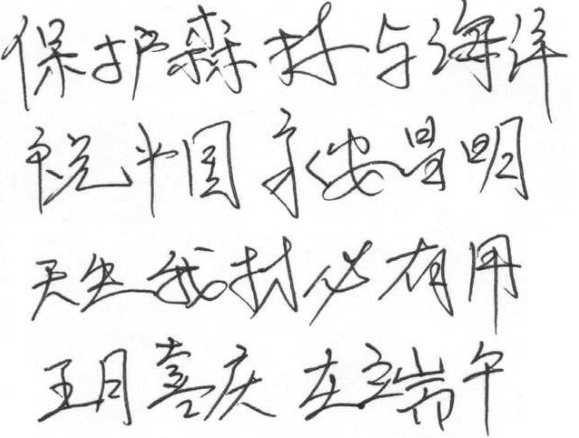Today we are going to talk about what it is like to write ugly words? Let's first talk about the relationship between the word "ugly" and "ability and character".
First, explain what is capability?
attention;
logical thinking ability;
speed;
Adaptability and adaptability;
mental endurance;
Interpersonal integration ability;
perception;
creativity.
Generally, there are four cases of ugly handwriting.
1. Ugly words, strong ability
2. The handwriting is ugly and the ability is weak
3. Ugly words, good personality
4. Ugly handwriting and poor personality
1. Ugly words, strong ability

The main reasons for the unsightly handwriting are: continuous writing, omitting some strokes, and very flexible line directions.
Common ability characteristics are:
1. Quick and quick thinking (fast writing speed, omitted strokes)
2. Strong logical thinking ability, smooth and coherent thinking, and good language expression ability (continuous writing)
3. Strong adaptability and adaptability, flexible thinking, good at adapting to changes, and generating creativity (the direction of the lines is very flexible)
2. The handwriting is ugly and the ability is weak.

The main reason for unsightly calligraphy is: disordered transitions between strokes.
Common ability characteristics are:
The thinking is not organized, the logical thinking ability is weak, and the work lacks planning (the transition between lines is disordered)
Lack of perseverance, easy to give up halfway (unstable handwriting pressure)
3. Ugly words but good personality

The main reason why the characters are not good-looking is that the direction of the lines is random and not regular enough.
Common personality traits are:
Kind, careless, happy-go-lucky, not concerned about material desires
(Note that ugly words do not necessarily mean kind words, but in this case, they are all kinder)
4. Ugly handwriting and poor personality

The main reasons for the unsightly characters are: chaotic transitions between lines, random and irregular directions, and sudden acceleration of lines.
Common personality traits are:
Insufficient ability to connect things and lack of ability to implement long-term planning (transitional disorder)
Lack of sense of rules (the direction is more random and not regular enough)
Emotions alternate between hot and cold (sudden acceleration)
We explain it in a scientific way"The writing is ugly"
"The writing is ugly" is used to describe a person's character and abilities. These are:
Pressure, speed, stability, transition, turning, head and tail, stage changes, contrast, volume ratio, inside and outside.
"Good-looking" is not used as an indicator here. why?
Because calligraphy is an art, and art is subjective. For the same word, some people think it looks good, while others think it looks ugly. This is a very normal phenomenon.
The factors that make a word "ugly" and their relationship with personality and ability are as follows:
1. Coherent transitions, continuous writing, and resulting omission of strokes - strong logical thinking ability
2. The transition is disordered and the lines lack a sense of rhythm - there is no plan in doing things, easy to be influenced by others, and the personality is disorganized
3. The speed is unstable, sometimes fast and sometimes slow - the personality changes unevenly, and it is easy to lose temper suddenly and unexpectedly.
4. The turning direction is arbitrary - do not follow the rules and break the rules. Some people are innovative and creative (such as case 1), some are kind and don't care about material desires (such as case 3), and some have weak sense of rules and easily break the rules (such as case 4)
To sum up, the word Chou has no direct correspondence with ability and character.
How should we practice calligraphy after understanding the above situation?
In fact, there are two different goals in practicing calligraphy.
The first goal is to pursue practical daily writing that can be written well, quickly, and easily legible.
The second goal is artistic writing that is beautiful and beautiful for people to appreciate.
Let’s now talk about the second goal
Regular script is the most suitable font for handwriting training. It is recommended to copy the standard Kai script (it is the Kai script printed by the computer, not handwritten by a calligrapher).
First, practice standardization and pursue the structural standards of characters, that is, standardize the glyph structure of characters.
Secondly, on the basis of writing standards, speed up and improve writing efficiency, that is, the ability to control the pen of words.
It is difficult for handwritten fonts to achieve the same effect as printed ones. Some people strictly abide by the rules and write one stroke at a time, which is very slow and reduces efficiency. This is also undesirable. We have to balance speed and accuracy. If you reduce the speed for the sake of accuracy, you are paying attention to one thing and losing the other.
If you want to achieve the standard regular script for handwriting copying, you first need to analyze the glyph structure of each character to see where the strokes and strokes are, and then start writing. If you find that the position is not correct when writing, then At this time, you need to correct it again until the word is written well.
Another one is the ability to control the pen. You may see why standard regular script has a pen edge. For example, when you look at the pen edge of the word "一", you also want to write this feeling, but you got it right after trying it. I just can’t write well, why? Because you don’t have the ability to control the pen. What is the ability to control the pen? It means that you can write with heavy pens and light pens. Why do I always urge everyone to master the posture of holding the pen well? That is, only by learning that good pen Only then can you better control the pen to write this word.
Therefore, I suggest that if you are not good at handwriting, you should first practice pen control. If you are not good at handwriting, you can take our calligraphy training course.
1. How to write? How to correct wrong writing methods?
2. How to use Tianzi grid for positioning?
single stroke
3~5. Three ways of writing points (oblique point, vertical point, up and down point)
6~8. Three ways of writing dots (opposing dots, opposite dots, and gathering four dots)
9~10. How to write horizontally (short horizontal, long horizontal)
11~12. How to write vertically (hanging needle vertically, hanging dew vertically)
13~15. Writing method of apostrophe (short apostrophe, oblique apostrophe, vertical apostrophe)
16~18. How to write 捺 (positive 捺, flat 捺, reverse 捺)
19~20. How to write TI (short TI, long TI)
21~22. How to write fold (horizontal fold, vertical fold)
23~25. How to write hook (vertical curved hook, horizontal hook, vertical hook)
26~28. How to write hook (lying hook, oblique hook, curved hook)
Combined strokes
29~31, horizontal turning, horizontal folding hook, horizontal bending
32~33, horizontal folding lift, horizontal folding hook
34~36, horizontal fold and oblique hook, horizontal fold and fold hook, horizontal fold and fold
37~41, vertical lifting, vertical folding hook, skimming fold, skimming point
Radicals: narrow on the left and wide on the right
42~45, next to the word 口, next to the word Tian, next to the word 日, next to the word single
46~49, next to two people, next to words, two points of water, three points of water
50~53, left ear knife, next to the scarf, next to the handle, next to the silk pattern
54~57, next to vertical heart, next to anti-dog, next to lifting soil, next to the word food
58~61, next to the character horse, next to the character bow, next to the character wood, next to the character sign
62~65, next to the character for fire, next to the character for shell, next to the character for Xie Wang, next to the character for moon
66~69, next to the word "car", next to the word "ox", next to the word "gold", next to the word "foot"
Radicals: wide on the left and narrow on the right
70~73, next to the standing sword, next to the right ear, next to the single sword, next to the three swords
74~77, beside the word ge, next to the word fan, next to the word jin, next to the word page
The location of radicals
78~81, the character for earth, the character for female, the character for nong, the character for heart
82~85, four-point bottom, bottom with the word "plate", bottom with the word "yi", bottom with the word "er"
radical radical
86~88, factory prefix, Guang prefix, household prefix
89~90, tiger prefix, human prefix
91~93, Jingzitou, Bald Baogai, Baogaitou
94~95, grass prefix, mountain prefix
96~97, four prefix, spring prefix
98~99, bamboo prefix, rain prefix
100~102, disease prefix, same word box, district word box
103~104, door frame, national frame
36 methods of word structure
105~121. Explain the 36 methods of Ouyang Xunjian frame structure, including folding, avoiding, top-wearing, interspersing, back-facing, etc. (Two structures are explained in one lesson)
How to do chapter practice
122. The technique of writing gracefully on horizontal lines
123. Tips for writing the entire article beautifully








